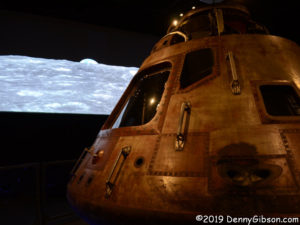 The vehicle that Michael Collins flew in circles waiting for his buddies to return is currently parked in the Cincinnati Museum Center. Apollo 11’s Command Module Columbia is on tour and doing a little overtime. The traveling exhibit, Destination Moon: The Apollo 11 Mission, was originally scheduled to appear in just four cities but the tour has been extended to include Cincinnati as a fifth and final stop. When the showing closes here in February, everything returns to a revamped home at the Smithsonian in Washington, DC.
The vehicle that Michael Collins flew in circles waiting for his buddies to return is currently parked in the Cincinnati Museum Center. Apollo 11’s Command Module Columbia is on tour and doing a little overtime. The traveling exhibit, Destination Moon: The Apollo 11 Mission, was originally scheduled to appear in just four cities but the tour has been extended to include Cincinnati as a fifth and final stop. When the showing closes here in February, everything returns to a revamped home at the Smithsonian in Washington, DC.

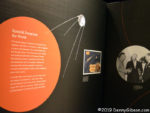
 The exhibit reminds visitors of mankind’s long-time dreams of reaching the moon and of the specific events that led to the first manned landing. The space race started to get serious — and scary — with the Soviet Union’s 1957 launch of Sputnik 1. Their hitting the moon less than two years later really underscored our second-place position. On May 25, 1961, after considerable discussion, President Kennedy announced plans to leap ahead of the Soviets by putting a man on the moon by the end of the decade.
The exhibit reminds visitors of mankind’s long-time dreams of reaching the moon and of the specific events that led to the first manned landing. The space race started to get serious — and scary — with the Soviet Union’s 1957 launch of Sputnik 1. Their hitting the moon less than two years later really underscored our second-place position. On May 25, 1961, after considerable discussion, President Kennedy announced plans to leap ahead of the Soviets by putting a man on the moon by the end of the decade.
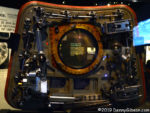

 The exhibit contains several artifacts from the mission but the star is the Command Module Columbia. Its hatch door is displayed separately which permits both sides to be studied.
The exhibit contains several artifacts from the mission but the star is the Command Module Columbia. Its hatch door is displayed separately which permits both sides to be studied.
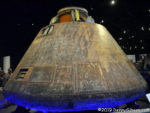 Columbia is, of course, the largest item in the exhibit. Surrounded by flat information panels and much smaller items, it automatically draws interest and initially looks rather big. It shrinks considerably, however, when viewed as a home for three men for eight days. It’s not quite 13 feet in diameter and the 218 cubic feet of space in the cabin isn’t much more than that of a typical minivan.
Columbia is, of course, the largest item in the exhibit. Surrounded by flat information panels and much smaller items, it automatically draws interest and initially looks rather big. It shrinks considerably, however, when viewed as a home for three men for eight days. It’s not quite 13 feet in diameter and the 218 cubic feet of space in the cabin isn’t much more than that of a typical minivan.
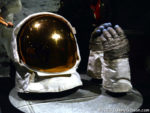 I had difficulty photographing most of the smaller mission artifacts in the exhibit such as the medical and survival kits, but Buzz Aldrin’s helmet and gloves were the things I was most interested in and a little extra effort produced a satisfactory picture.
I had difficulty photographing most of the smaller mission artifacts in the exhibit such as the medical and survival kits, but Buzz Aldrin’s helmet and gloves were the things I was most interested in and a little extra effort produced a satisfactory picture.
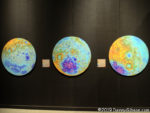 Seeming to fill just about as much space as the physical artifacts, is a display of photographs taken in the decades since humans last visited the moon in person. For those having and seeking knowledge of the moon’s surface, these large images are possibly even more interesting than the fifty-year-old hardware.
Seeming to fill just about as much space as the physical artifacts, is a display of photographs taken in the decades since humans last visited the moon in person. For those having and seeking knowledge of the moon’s surface, these large images are possibly even more interesting than the fifty-year-old hardware.

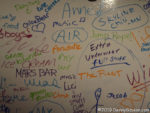 Whiteboards in the hallway leading in and out of the exhibit invite comments on some moon related questions such as “Should we return?” and “What would you take if you went?” A couple of people said they’d take Skyline Chili. Others planned on taking a Mars Bar or green M & Ms. Those are all good ideas but maybe not quite as practical as taking extra underwear. As for how the moon should be used, one person thought it would be a good place to explode stuff and another saw it as a good location for a Disneyland. I was encouraged by multiple “stepping stone to Mars” ideas and discouraged by at least two “leave it alone” suggestions.
Whiteboards in the hallway leading in and out of the exhibit invite comments on some moon related questions such as “Should we return?” and “What would you take if you went?” A couple of people said they’d take Skyline Chili. Others planned on taking a Mars Bar or green M & Ms. Those are all good ideas but maybe not quite as practical as taking extra underwear. As for how the moon should be used, one person thought it would be a good place to explode stuff and another saw it as a good location for a Disneyland. I was encouraged by multiple “stepping stone to Mars” ideas and discouraged by at least two “leave it alone” suggestions.
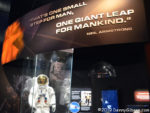 I attended Destination Moon as part of a Friday evening members-only event. Other portions of the museum center open for the evening included the Neil Armstrong Space Exploration Gallery where a movie about the famous Ohioan is shown and several artifacts are on display. The gallery opened as part of the Apollo 11 fiftieth anniversary celebration. Future additions are planned. The suit in the picture is an accurate replica. The suit Armstrong wore on the moon is in the Smithsonian. Its backup and the suit he wore on Gemini 8 are at the Armstrong Air & Space Museum which I visited on the anniversary of the Apollo 11 launch. That blog entry is here.
I attended Destination Moon as part of a Friday evening members-only event. Other portions of the museum center open for the evening included the Neil Armstrong Space Exploration Gallery where a movie about the famous Ohioan is shown and several artifacts are on display. The gallery opened as part of the Apollo 11 fiftieth anniversary celebration. Future additions are planned. The suit in the picture is an accurate replica. The suit Armstrong wore on the moon is in the Smithsonian. Its backup and the suit he wore on Gemini 8 are at the Armstrong Air & Space Museum which I visited on the anniversary of the Apollo 11 launch. That blog entry is here.
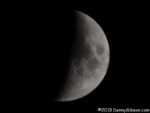
 The Museum Center’s OMNIMAX theater was also open Friday evening so I watched Apollo 11: First Steps Edition for the second time. The first time was on the anniversary of the Apollo 11 landing which was also part of the blog entry previously mentioned. When I finally stepped outside the museum, I was surprised to see several large telescopes set up in front of the building. I was aware of an Observe the Moon Night scheduled for Saturday but not this. I guess they decided to do an extra night in conjunction with the members-only Destination Moon event. I stood in line for a bit and was treated to an incredible view of the moon’s surface. At my car, I put on a long lens, steadied the camera against the roof, and got an OK picture but nothing remotely like what I had just seen inside the museum or through the telescope.
The Museum Center’s OMNIMAX theater was also open Friday evening so I watched Apollo 11: First Steps Edition for the second time. The first time was on the anniversary of the Apollo 11 landing which was also part of the blog entry previously mentioned. When I finally stepped outside the museum, I was surprised to see several large telescopes set up in front of the building. I was aware of an Observe the Moon Night scheduled for Saturday but not this. I guess they decided to do an extra night in conjunction with the members-only Destination Moon event. I stood in line for a bit and was treated to an incredible view of the moon’s surface. At my car, I put on a long lens, steadied the camera against the roof, and got an OK picture but nothing remotely like what I had just seen inside the museum or through the telescope.
